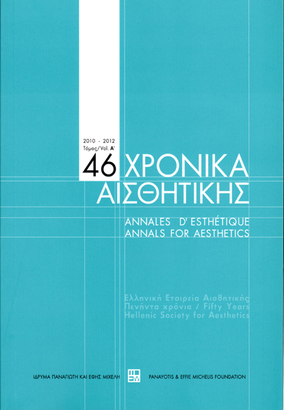Εικών και λόγος : η περιγραφή έργων τέχνης στη βυζαντινή γραμματεία
Part of : Χρονικά αισθητικής : ετήσιον δελτίον της Ελληνικής Εταιρείας Αισθητικής ; Vol.29-30, No.1, 1990, pages 109-126
Issue:
Pages:
109-126
Parallel Title:
Word and image : the description of works of art in byzantine literature
Abstract:
The 2nd century A.D. author Longos writes an erotic novel, taking as an excuse a painting which he supposedly saw in a cave on the island of Lesbos and which he intends to expound in his text. The preface of the romance establishes the desire of poets to incorporate, describe and override the visual work of art. Narration and description stand in an antagonistic relation, which the author controls, intervening between the described work and the reader.On account of its conscious artifice and lack of “classical naivity” ekphrasis (that is, the description of works of art) has been generally condemned by modern critics. But, in fact, it is a means for aesthetic expression as well as social, political and religious criticism. The present study attempt to trace in very broad lines the attitude of Byzantine literati towards the visual arts through the use of ekphrasis.One important factor in the development of ekphrasis in Byzantium is the rivalry between pagan and Christian ideology: only when the Church Fathers accepted pagan literature and philosophy as part of their thinking could the merging of the two opposites take place. Three epigrams from the 6th, late 8th and 11th centuries on Christian subjects demonstrate the philosophical relation between the described work of art, seen as the gate to the higher vision of the divine, and its literary description.The remaining three texts have secular subjects. One is a 12th century description of a late antique mosaic, where the author interferes with the description, subverts the artist’s craft through praise and asserts his own dexterity in a playful game of allusions with the reader. A further example shows the ekphrasis incorporated in a longer narrative text, in this case a description from an erotic romance of the 14th century. The last example is an early 15th century ekphrasis of a French gobelin, written in Paris. The author, in choosing a Western subject and describing it in the language of Byzantine literature, establishes a dialogue with another culture. He does not interfere with the description and conveys a sense of emotional immediacy. Thus, towards the end of Byzantium, we can observe through the history of ekphrasis the passage from the Middle Ages to the Renaissance.
Subject:
Subject (LC):
Notes:
Η παρούσα μελέτη είναι επεξεργασμένη μορφή μιας διάλεξης που δόθηκε στίς 25-2-92 στο Μουσείο Μπενάκη. Οι μεταφράσεις των αρχαίων και βυζαντινών κειμένων έχουν γίνει ειδικά για την περίσταση.




